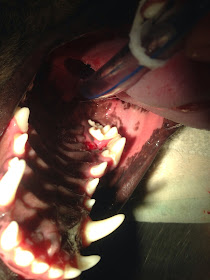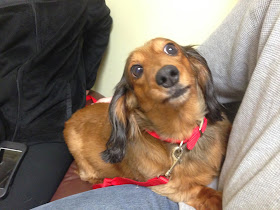 |
| Chloe smiles for our selfie. |
Those emotions also leave some us to be enslaved to an emotional roller coaster of inner turmoil.
You can't have one strong emotional attachment, like love for our pet, and not have the rest of the emotional baggage that goes along for the ride.
Guilt and fear are the ugly step sisters to love. I have to remind myself that my clients might not admit it, but much of their reasoning, reactions, and behaviors are due to guilt and fear.
These two terrorists harbor nothing positive for you or your pet when it comes to healthcare.
As your vet I will admit that I get afraid too. I also have a decade of experience to remind me that there are always consequences. Fear of knowing the truth doesn't allow you a different truth. It just provides you a shorter list of opportunities. Fear of anesthesia only leaves you with regret when the operable mass, dental disease, or failure to spay at 6 months old is now your pets death sentence. Fear of cost will cost your conscious. Fear of treating to spare your pet the pain of a treatment is an unfounded assumption.
There isn't one fear in your heart that we haven't thought of, planned for, nor provided an answer to. Say it out loud to us. We will listen and we will be your pets champion. BUT, this discussion can only happen with the foundation of trust in place.
You have to trust in your heart that we have your pets best interest in our hearts. If you don't nothing that follows, nor any decision that you make will feel right, settle peacefully, nor help you face the same emotional hostages the next time.
I know that we veterinarians can seem a bit reserved and composed when we talk about all of the scary things we do routinely. But, doing them routinely keeps us emotionally able to perform our jobs. Would you want a crying hysterical surgeon standing over you? No, we can't concentrate on your pet, or our task, if we are in a fog of fear, guilt, or emotional instability.
I had a very good reminder of these the other day.
One came in the form of a Pawbly question. Monalisa asked;
"Can a vitamin liquid supplement cause your 3 year old cat to die prior to your pet having a severe sickness?"
Here is my answer;
I receive many questions from clients reeling from the loss of their pet and desperate to try to identify what happened to ease their guilt and despair. The answer is always incredibly difficult to answer. Primarily because I empathize with the terrible burden of pain that it is to bear losing a pet.
So, first, I always remind my clients that their greatest gift to their pet was their love to them. It is the greatest joy to share your life with a pet, and the hardest thing to lose them. BUT, without you they may have never known love, or laughter, or what a real home is. That is everything. You were everything to your pet and I am sure your pet is grateful for the time they had with you.
Many pets die without us knowing why or what happened. Some of them can hide or mask signs of illness and this makes understanding that they need medical help difficult.
Can poisonings or toxicities occur? Yes, I am always very conservative with the products I recommend because the labeling and rules on pet products are not as strict and stringent as they are with human products.
Is it likely that it was the supplement? Probably not. But there is really no point in beating yourself up over loving your cat. I'm sure that you were trying to provide them the best life possible.
I hope that this helps, and please don't hesitate to ask about how we can help you care for your pets. That's what we are here for.
My deepest sympathies.
Your pet knows that life is something that you live in this moment. No fear, no regrets, no second to trade for this one. They also know that you are the best
And from a friend I received this;
I would like to talk to you about my dog who is 10. I am terrified about his lumpy leg. He had FNA twice in recent years. It was diagnosed as a lipoma, but so big now. Feel OK talking to you.
If he needs surgery I think I'd like you to do it.
My friend also sent me this; The Secret Reason Your Clients Are Afraid.
My answer back;
"I'm happy to see you both. Please call the office and schedule an appointment."
That was 5 days ago. No call and no reply from my very devoted pet parent friend.
I sent a note asking if she had gotten my reply? She confessed that her fear was crippling her. She was so afraid she couldn't pick up the phone and call my office, or reply to my email.
"What if I look at it and decide it isn't significant enough to even discuss removing? Why don't we take it one step at a time?"
Where do I think my best advice lies? Well, I suppose we all need to be brave enough to open up the dialogue by opening up our mouths, confessing the emotions of our hearts, and build a meaningful relationship centered around trust.
Your pet lives in the here and the now. They are free from guilt and fear and live with love and joy. It is our job to think and act for a happier and healthier tomorrow. Be proactive and become the master of both your destinies.. and always keep a little bit of faith in your heart.
Related Blogs;
There Has To Be Mercy Before Money.
Too Afraid To Fail. When Your Fear Costs Your Patients.
How Do Our Perceptions Lead Us?
To ask a pet question on Pawbly.com just sign up and ask away. All questions are free to ask and the Pawbly community will add their thoughts and opinions. Pawbly is free for all to participate.
If you would like an appointment with me, or any of the other amazing people at the clinic please find our information on our Jarrettsville Vet website or Jarrettsville Vet Facebook page.
I am also on Twitter @FreePetAdvice.


















































